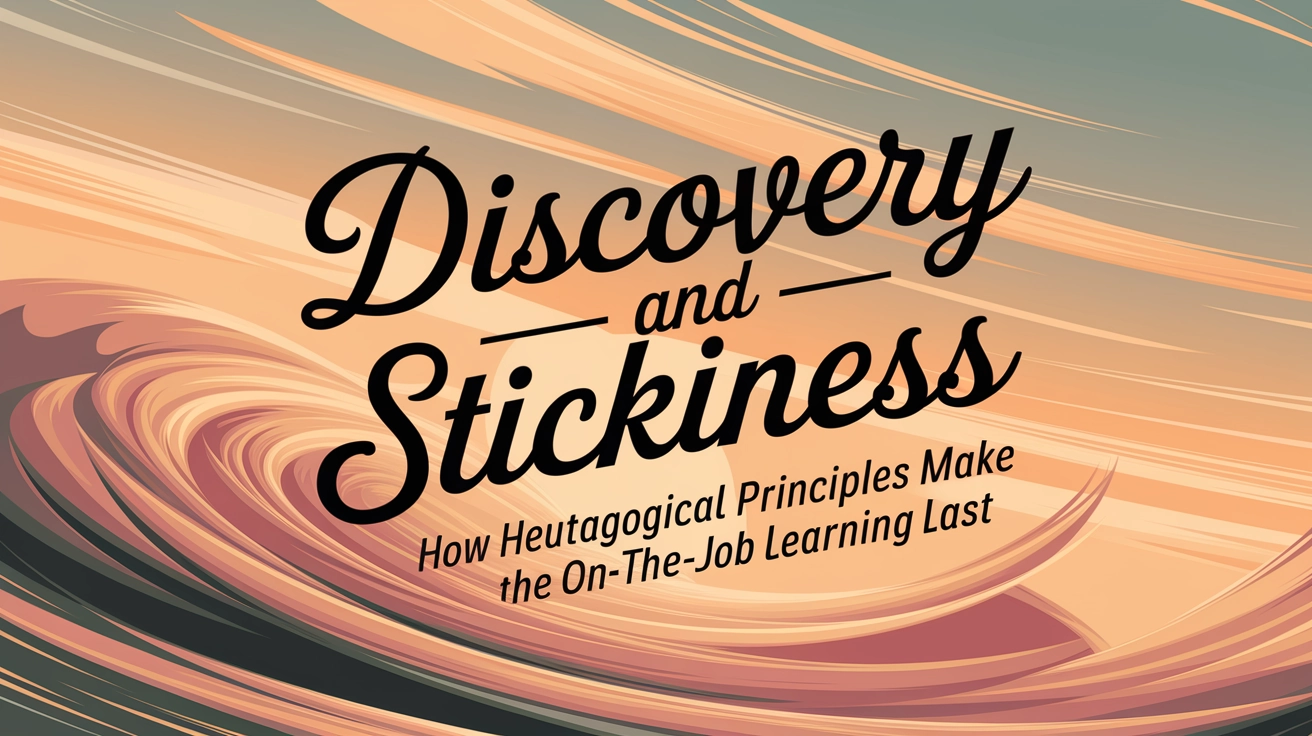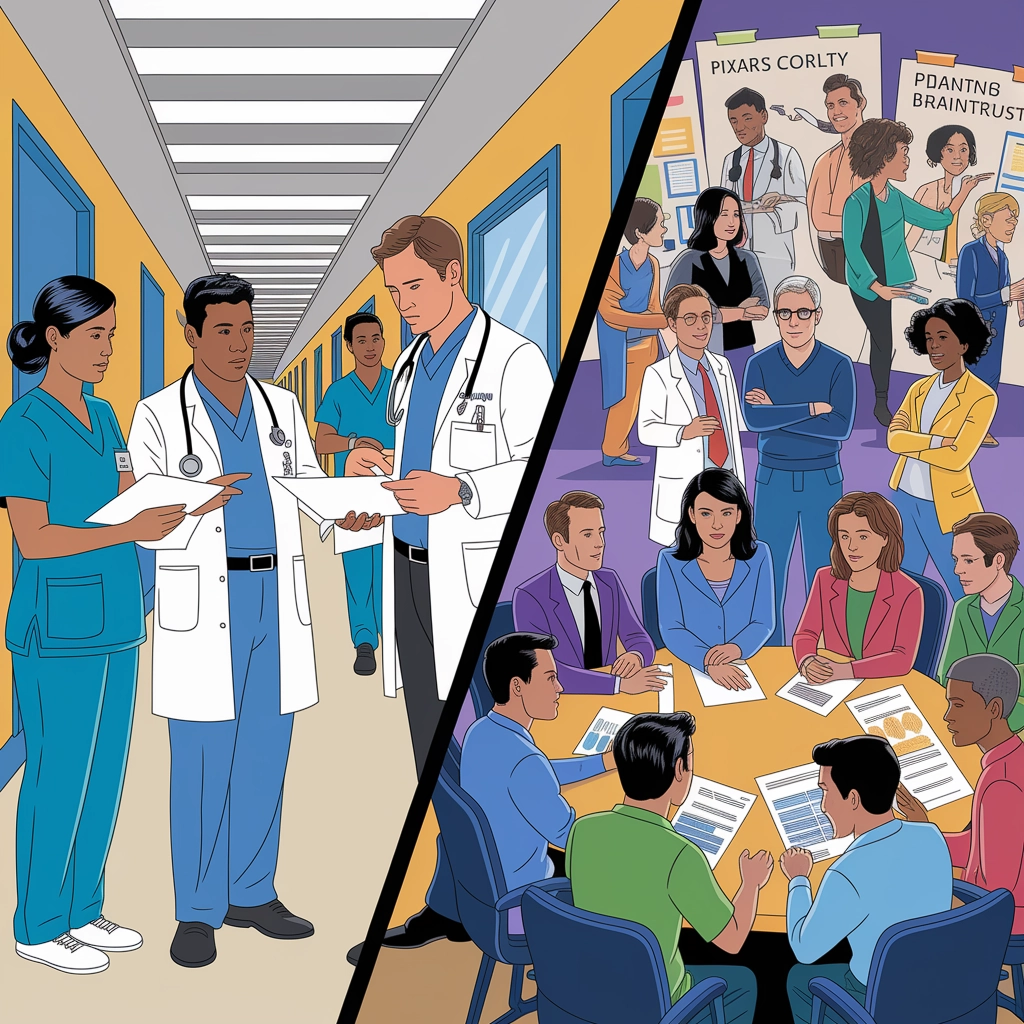Discovery and Stickiness: How Heutagogical Principles Make On-the-Job Learning Last
Jun 10, 2025 4:12 pm
Discovery and Stickiness: How Heutagogical Principles Make On-the-Job Learning Last

The Problem with Traditional Professional Learning
We've all been there—sitting through professional development sessions where information washes over us like a wave. We nod politely, take notes we'll rarely revisit, and return to our jobs where approximately 70% of what we "learned" evaporates within days. This isn't just frustrating; it's a colossal waste of organizational resources and human potential.
But what if there was a better way? What if the key to making learning "stick" wasn't about better presentations or more engaging speakers, but about fundamentally changing how we approach the learning process itself?
Enter Heutagogy: Learning by Discovery
Heutagogy—from the Greek word "heut" meaning self—represents a radical shift from traditional pedagogy. While pedagogy positions the teacher as the knowledge-keeper, heutagogy places the learner in the driver's seat. It's an approach that recognizes adults not just as recipients of knowledge, but as capable architects of their own learning journeys.
At the heart of heutagogical learning is the principle of discovery—the idea that what we uncover for ourselves becomes infinitely more meaningful than what we're simply told.

Why Discovery Creates "Stickiness" in Learning
When we talk about "sticky" learning, we're referring to knowledge that persists—information that doesn't just enter short-term memory only to be forgotten, but becomes integrated into our professional practice. The discovery principle of heutagogy creates this stickiness through several powerful mechanisms:
1. Neurological Engagement
Discovery-based learning activates multiple neural pathways. When we actively explore, question, and problem-solve, our brains form stronger, more diverse connections than when we passively receive information. The hippocampus—our brain's memory center—lights up more intensely during discovery moments than during direct instruction.
2. Emotional Connection
Discoveries generate emotional responses—surprise, satisfaction, even frustration that leads to eventual triumph. These emotional markers tag learning moments as significant, prioritizing them in our memory architecture. Think about it: you likely remember the work problems you solved through trial and error far more vividly than those for which you simply followed instructions.
3. Contextual Relevance
When learning happens through discovery in the actual context where knowledge will be applied, the transfer problem (applying learning from one context to another) essentially disappears. The learning and application environments are one and the same.
4. Ownership and Autonomy
Perhaps most importantly, discovery-based learning creates a sense of ownership. As organizational psychologist Adam Grant notes, "When people help design their own learning experiences, they become investors rather than tenants in their own development."
Heutagogical Discovery in Professional Settings: Real-World Examples
Case Study: The Accidental Learning Revolution at Pixar
Pixar's renowned "Braintrust" meetings operate on heutagogical principles without explicitly naming them as such. When facing creative challenges, teams don't receive top-down solutions. Instead, they present problems to peers who offer perspectives that spark new insights. This discovery-driven approach has consistently produced breakthrough innovations and has been credited by Pixar leadership as the "secret sauce" behind their creative success.
Case Study: Medical Residency Programs
Medical residency has long embraced discovery learning through the principle of "see one, do one, teach one." While modern medical education has added guardrails to this approach, the core concept remains: physicians in training learn most effectively by progressively discovering how to apply knowledge in real clinical scenarios, not by memorizing procedures from textbooks.

Five Practical Strategies to Implement Discovery-Based Learning at Work
1. Replace Solutions with Questions
When a team member asks for help, resist the urge to provide an immediate answer. Instead, respond with, "What approaches have you considered?" or "What do you think is the underlying issue here?" This simple shift initiates a discovery process rather than short-circuiting it.
2. Create Structured Exploration Spaces
Set aside deliberate time for what I call "bounded experimentation"—periods where professionals can explore new approaches within defined parameters. This might look like:
- Innovation hours (similar to Google's famous 20% time)
- Problem-solving circles where teams tackle challenges without managerial input
- Job shadowing in adjacent roles to discover new perspectives
3. Normalize Productive Failure
Discovery learning inherently involves false starts and dead ends. Organizations that punish failure drive learning underground. Instead, create rituals that celebrate the learning that comes from unsuccessful experiments:
- "Failure Friday" share sessions
- Project post-mortems that focus on discoveries rather than blame
- Recognition systems that reward valuable learning, not just successful outcomes
4. Design for Reflection, Not Just Action
Discovery without reflection is just activity. Build reflective practices into the workflow:
- Guided journaling prompts for weekly learning
- Peer coaching conversations focused on insights
- "What did we learn?" as a standing agenda item for all meetings
5. Scaffold, Don't Spoon-feed
Provide frameworks and resources rather than step-by-step instructions. For example, instead of a detailed protocol for client interactions, provide key principles and examples, then allow professionals to discover their own effective approaches.
Designing "Sticky" Professional Development Programs
For those responsible for professional learning—whether you're a consultant, coach, or organizational leader—heutagogical principles can transform your approach.

From Content Delivery to Discovery Facilitation
Traditional PD focuses on content delivery; heutagogical PD designs discovery experiences. This means:
- Beginning with problems, not solutions
- Providing resources rather than answers
- Creating conditions for insight rather than delivering prescriptions
From Standardized to Personalized
One-size-fits-all professional development contradicts what we know about effective adult learning. Heutagogical approaches honor the unique starting points and learning paths of each professional:
- Offering choice in learning pathways
- Building from existing knowledge and experience
- Allowing for personalized application of concepts
From Event-Based to Journey-Oriented
The "workshop as event" model rarely creates lasting change. Heutagogical professional development embraces learning as an ongoing journey:
- Extending learning over time with spaced discovery opportunities
- Creating communities of practice that sustain exploration
- Designing follow-up structures that prompt continued discovery
Measuring the Impact of Discovery Learning
How do we know if discovery-based learning is actually "stickier" than traditional approaches? Look for these indicators:
- Application frequency: Are learners spontaneously applying new approaches?
- Adaptation evidence: Are they modifying what they've learned to fit new contexts?
- Sharing behaviors: Are they teaching others what they've discovered?
- Question evolution: Are their questions becoming more sophisticated over time?
- Initiative indicators: Are they independently seeking new learning opportunities?
The Path Forward: From Training Culture to Discovery Culture
The most profound shift happens when organizations move from a training culture (where learning is something "done to" employees) to a discovery culture (where learning is woven into the fabric of work itself).
This transformation doesn't happen overnight, but it begins with recognizing that the most valuable learning often doesn't look like learning at all—it looks like people solving real problems, reflecting on their experiences, and sharing their discoveries with others.
Taking the First Step
Ready to make professional learning "stickier" through discovery? Start with these actions:
- Identify one upcoming learning initiative that could be redesigned around discovery principles
- Look for natural learning moments in your workplace that could be amplified
- Experiment with one of the five strategies outlined above
- Notice where learning already happens through discovery and find ways to make those processes more intentional
The journey toward more effective professional learning doesn't require a complete organizational overhaul. It starts with recognizing a simple truth: what we discover for ourselves, we rarely forget.
Ready to transform professional learning in your organization? Let's start a conversation about how discovery-based approaches can make learning stick.

